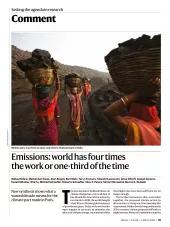This comment published in “Nature” uses the last ten UNEP Emissions Gap Reports to show what a wasted decade means for the climate pact made in Paris.
Press Release:
A decade of insufficient political action on climate change means that nations must now do four times the work — or do the same in one-third of the time — to comply with the climate pact they made in Paris, argue Niklas Höhne and colleagues in a Comment piece in this week’s Nature. The authors’ conclusions are based on a synthesis of all ten editions of the Emissions Gap Report produced by the United Nations Environment Programme (UNEP). Each year for the past ten years, this report has examined the difference (the ‘gap’) between what countries have pledged to do individually to reduce greenhouse-gas emissions, and what they need to do collectively to meet agreed temperature goals.
Höhne and co-authors find that the required emissions cuts from 2020 to 2030 are now more than 7% per year on average for the 1.5 °C temperature limit set in Paris and 3% for 2°C. Had serious climate action begun in 2010, the cuts required to meet the emissions levels for 2 °C would have been 2% per year, on average. The time window for halving global emissions has also narrowed: today it is 10 years for 1.5 °C and 25 years for 2°C; it would have been 30 years in 2010. “The gap is so huge that governments, the private sector and communities need to switch into crisis mode, make their climate pledges more ambitious and focus on early and aggressive action,” the authors write.
Some countries, regions, cities and businesses have promised or implemented urgently needed climate action, however. For example, 76 countries or regions and 14 subnational regions or states have set or even implemented net-zero emissions goals. Closing the gap will require scaling up these few success stories and mirroring them with progress in every sector, the authors conclude.




